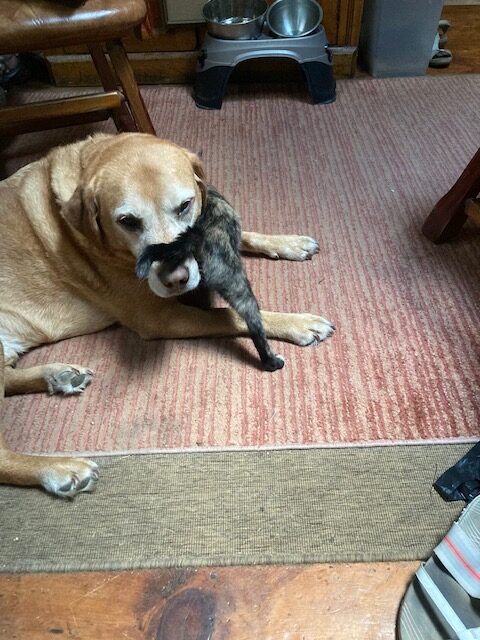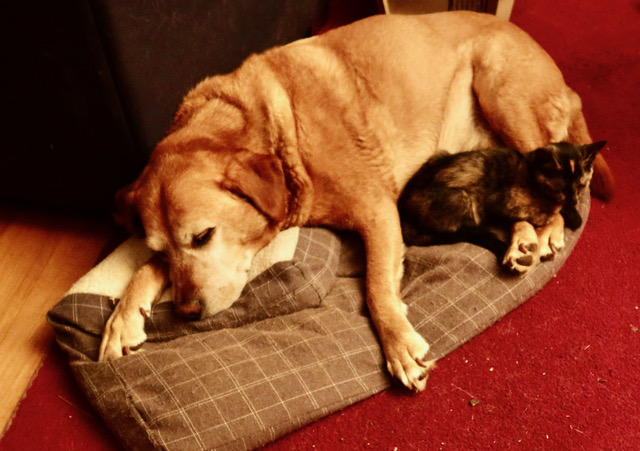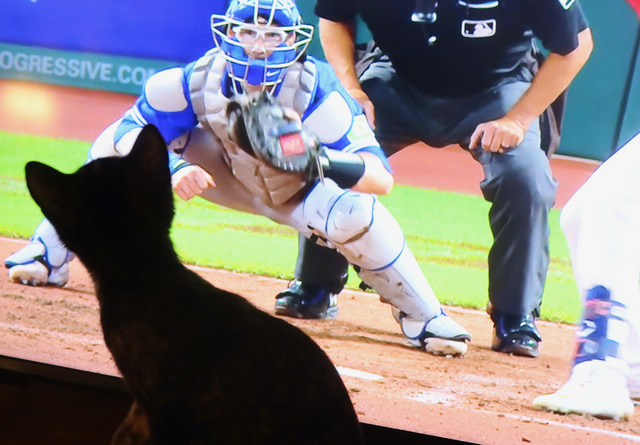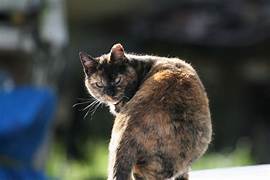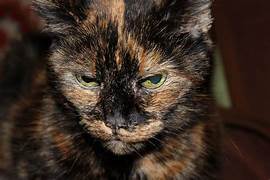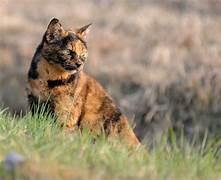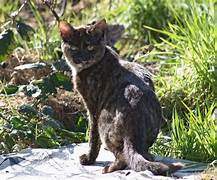EPISODE 855 DID A FERAL TOM CAT COME FOR A VISIT WITH CHELSEA BUN (father of our kitten)
alan skeoch
august 31,2023
IMAGES OF OUR KITTEN (ABOVE)
IMAGES OF FERAL TOMCATS (BELOW)
ALAN, I NEED HELP
“Alan, stop the tractor, I need help!”
“What’s the problem?”
“The cat got out…I saw her heading for the swamp,”
“How did she escape?”
“I have no idea…doors were closed.”
Our new family addition is CHELSEA BUN so named because she
looks like a Chelsea bun…dark with patches of cream coloured fur here and there…one definite whitish paw and a
cream coloured dollop between her eyes. She is not likely to win a prize at a cat show. Here tail is broken. But she is the
smartest cat we have ever owned. Smart enough to dart out a crack in the door without us noticing.
You go around the swamp from one side, I will go the other way shaking the food bag.
Maybe we can get her before a coyote does.”
“Not much danger of coyotes here at the farm.”
“City coyotes are far more numerous.”
“A few years ago neighbourhood cats roamed quite freely today we have not seen
a cat for years. Cats make a good coyote dinner except for the fur which is obviously excreted in coyote dung.
Few coyotes at the farm. But they are present if unseen. So we were a bit anxious.
We were given Chelsea Bun by a farm neighbour, Elizabeth Porter. She had a surprise batch of kittens in March
…the result of a feral Tom Cat who briefly visited and left his calling card. Tom cats are rare. Most are
,fixed, (i.e. castrated) . Tom cats are generally unwelcome…like stallions, bulls, boars and other males.
We did know one thing about the father of our kitten. He was tortoise shell …. like the Chelsea bun.
But that is all tha was known. No one saw him do the ‘job’ on the neighbour farm cat. It was likely a night time
romance.
“Our kitten must look like the father” said Elizabeth. So different from their mother.
I searched one side of the swamp and could hear Marjorie shaking the cat food box. We found nothing.
“Where did you see her?”
“Down by he Shaver barn…..she darted across to the swamp. Lean and swift…no intention of
being tricked by food.”
“Let’s give up and hope she comes back on her own.”
So we went back to the farm house and guess what we found?
“Alan, the kitten is back in the house.”
“Impossible.”
Chelsea Bun was snuggling up against Marjorie as if nothing had happened.
And nothing had happened, No escape at all. Then sho in hell were we searching for in
the swamp?
“I think that was Chelsea Bun’s father. Looked exactly like Chelsea Bun….tortoise shell colours.
“A wild cat…feral”
“But our farm is several kilometres from the Porter/Kilner farn Seems a long distance.”
“Maybe not.”
“Do you think the Tom cat came to see his daughter…to see Chelsea Bun?”
“I think that is pushing things. Cats are not people.”
“Maybe he is living in one of our barns but cautious and never seen.”
“Like the coyotes.
EVIDENCE SEEMS TO SUPPORT THE IDEA THAT THIS FERAL TOM CAT WAS REALLY THE FATHER
OF CHELSEA BUN, DID HE REALLY COME TO CHECK UP ON HIS DAUGHTER?. NOW THAT IS PURE CONJECTURE.
TOM CAT TERRITORY
1,351 acres (2.1 square miles)
- EXCERPT: The scientists found that the feral cats had home ranges that stretched across large areas; one male kitty’s range covered 1,351 acres (2.1 square miles). They roamed over a wide variety of habitats, most often in urban areas and grasslands, including a restored prairie.
In winter, they preferred urban spots, forests and farmland, all places that would provide greater shelter from bad weather and help them keep warm. Cats that had owners, meanwhile, tended to stick close to home, with their range sizes averaging a mere 4.9 acres.
Feral kitties were also more active than cats that had homes. Unowned cats spent 14 percent of their time in what the scientists classified as “high activity” (running or hunting, for example), compared with only 3 percent for kitties with owners. “The unowned cats have to find food to survive, and their activity is significantly greater than the owned cats throughout the day and through the year, especially in winter,” saysstudy co-author Jeff Horn of the University of Illinois.
In addition, the feral cats’ daily activity patterns—sleeping during the day and being active at night, which likely reflects the behavior of their prey, small mammals, as well as lets them better avoid humans—was very different from kitties with homes. Those animals were most active in the morning and evening, when their owners were likely home and awake.
Only one owned kitty died during the study, compared with six feral cats. Two of the feral cats were killed by coyotes, and the researchers believe that at least some of the others were killed by other cats, as the owned kitty was. Cats that live outdoors, even just part of the time, are at risk of death from other cats as well as diseases
POST SCRIPT
ONE winter evening about 30 or 40 years ago we watched the milking time at the Townsend dairy farm. (near Bellwood) There were 23 feral cats
watching along with us. I counted them. Occasionally cousin Eleanor would grab a teat and direct a shot of milk at one of the cats. Not a drop
was lost. These cats had all arrived on their own. They were feral. Warm home for the winter.
alan skeoch
